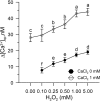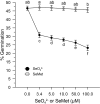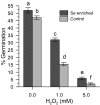Selenium-Enriched Pollen Grains of Olea europaea L.: Ca2+ Signaling and Germination Under Oxidative Stress
- PMID: 31921256
- PMCID: PMC6917658
- DOI: 10.3389/fpls.2019.01611
Selenium-Enriched Pollen Grains of Olea europaea L.: Ca2+ Signaling and Germination Under Oxidative Stress
Abstract
Selenium (Se) shows antioxidant properties that can be exploited in plants to combat abiotic stresses caused by reactive oxygen species produced in excess (ROS). Here, we show that the Se-fertilization of olive trees with sodium selenate effectively protects the pollen from oxidative stress. Pollen isolated from plants treated with Se or from untreated controls was incubated in vitro with H2O2 to produce an oxidative challenge. Given the impact of ROS on Ca2+ homeostasis and Ca2+-dependent signaling, cytosolic Ca2+ was measured to monitor cellular perturbations. We found that H2O2 interrupted Ca2+ homeostasis only in untreated pollen, while in samples treated in vitro with sodium selenate or selenium methionine, Ca2+ homeostasis was preserved. Furthermore, germination rates were considerably better maintained in Se-fertilized pollen compared to non-fertilized pollen (30% vs. 15%, respectively) after exposure to 1 mM H2O2. The same was observed with pollen treated in vitro with Se-methionine, which is the organic form of Se, in which part of the fertigated sodium selenate is converted in the plant. Combined, our results show a close correlation between ROS, Ca2+ homeostasis, and pollen fertility and provide clear evidence that Se-fertilization is a potential approach to preserve or improve agricultural productivity.
Keywords: cytosolic Ca2+; olive; pollen germination; se-fertilization; se-methionine; selenium.
Copyright © 2019 Del Pino, Regni, D’Amato, Tedeschini, Businelli, Proietti and Palmerini.
Figures






Similar articles
-
Persistence of the Effects of Se-Fertilization in Olive Trees over Time, Monitored with the Cytosolic Ca2+ and with the Germination of Pollen.Plants (Basel). 2021 Oct 25;10(11):2290. doi: 10.3390/plants10112290. Plants (Basel). 2021. PMID: 34834652 Free PMC article.
-
Selenium maintains cytosolic Ca2+ homeostasis and preserves germination rates of maize pollen under H2O2-induced oxidative stress.Sci Rep. 2019 Sep 18;9(1):13502. doi: 10.1038/s41598-019-49760-3. Sci Rep. 2019. PMID: 31534157 Free PMC article.
-
Selenium maintains Ca2+ homeostasis in sheep lymphocytes challenged by oxidative stress.PLoS One. 2018 Jul 30;13(7):e0201523. doi: 10.1371/journal.pone.0201523. eCollection 2018. PLoS One. 2018. PMID: 30059547 Free PMC article.
-
The role of reactive oxygen species and nitric oxide in programmed cell death associated with self-incompatibility.J Exp Bot. 2015 May;66(10):2869-76. doi: 10.1093/jxb/erv083. Epub 2015 Mar 7. J Exp Bot. 2015. PMID: 25750430 Review.
-
Pollen development at high temperature and role of carbon and nitrogen metabolites.Plant Cell Environ. 2019 Oct;42(10):2759-2775. doi: 10.1111/pce.13576. Epub 2019 Jun 19. Plant Cell Environ. 2019. PMID: 31077385 Review.
Cited by
-
Persistence of the Effects of Se-Fertilization in Olive Trees over Time, Monitored with the Cytosolic Ca2+ and with the Germination of Pollen.Plants (Basel). 2021 Oct 25;10(11):2290. doi: 10.3390/plants10112290. Plants (Basel). 2021. PMID: 34834652 Free PMC article.
-
Effects of Megafol on the Olive Cultivar 'Arbequina' Grown Under Severe Saline Stress in Terms of Physiological Traits, Oxidative Stress, Antioxidant Defenses, and Cytosolic Ca2.Front Plant Sci. 2021 Jan 15;11:603576. doi: 10.3389/fpls.2020.603576. eCollection 2020. Front Plant Sci. 2021. PMID: 33519855 Free PMC article.
-
The First Evidence of the Beneficial Effects of Se-Supplementation on In Vitro Cultivated Olive Tree Explants.Plants (Basel). 2021 Aug 9;10(8):1630. doi: 10.3390/plants10081630. Plants (Basel). 2021. PMID: 34451675 Free PMC article.
-
In Vitro Oxidative Stress Threatening Maize Pollen Germination and Cytosolic Ca2+ Can Be Mitigated by Extracts of Emmer Wheatgrass Biofortified with Selenium.Plants (Basel). 2022 Mar 24;11(7):859. doi: 10.3390/plants11070859. Plants (Basel). 2022. PMID: 35406839 Free PMC article.
-
Selective Inhibition of Wild Sunflower Reproduction with Mugwort Aqueous Extract, Tested on Cytosolic Ca2+ and Germination of the Pollen Grains.Plants (Basel). 2021 Jul 3;10(7):1364. doi: 10.3390/plants10071364. Plants (Basel). 2021. PMID: 34371567 Free PMC article.
References
LinkOut - more resources
Full Text Sources
Research Materials
Miscellaneous

